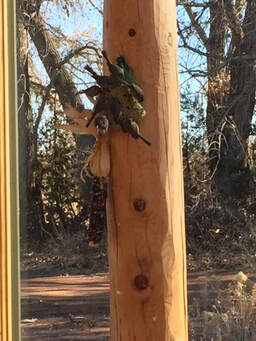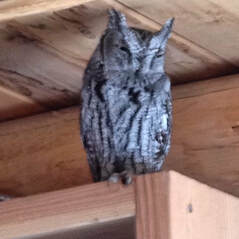 Late in December I noticed one morning that my suet was covered with tiny little light gray birds that I had never seen before. About thirty clustered together almost like the way bats do. High pitched chirps, peeps, and chattering filled the air. All plumages of these little birds are similar; They have gray caps, blue-gray upper-parts, and white or buff colored under - parts. I continued to be regaled by these little birds for about two months. They are now disappearing either because they are migrating elsewhere or in part because at least one hundred noisy evening grosbeaks have taken over the porch. The Pygmy Nuthatch (Sitta pygmaea) is a tiny roundish songbird less than four inches long. They range from British Columbia, south through various ‘discontinuous’ parts of the northwest, Sierra Nevada range, southern Rockies and down to Mexico. Pygmy nuthatches are amazing acrobats, clambering through the cottonwood branches; less often they creep along limbs or the trunk like bigger nuthatches. I can literally watch them for hours. They are supposed to live almost exclusively in long-needled pine forests and are particularly closely associated with ponderosa pines. Their normal forest habitat includes stands of older, large trees, pines, oak, aspen maple and fir so what were they doing here? Since they depend upon cavities in old trees (snags) for roosting and nesting, Pygmy Nuthatches are most abundant in forests that have escaped heavy logging and snag removal. They range up to 10,000 feet in the California mountains, and even higher in Mexico. Pygmy Nuthatches eat insects, other invertebrates and seeds. Here, besides the suet cakes they loved (a fact that this writer never found in print) they also feasted on both sunflower and mixed seeds. During the breeding season they eat mostly arthropods—including beetles, wasps, ants, bugs, caterpillars, and spiders—by probing cracks, scaling off loose bark, and gleaning from needle clusters and cones. Pygmy Nuthatches cache seeds year-round by hammering them into crevices or under flakes of bark on the tree, saving them for later. The male appears to take the lead in choosing a woodpecker hole or natural cavity as a nest site, usually in the trunk of a ponderosa pine or other long-needled pine, but sometimes in other species. Pygmy Nuthatches nest in live trees, dead trees, dead parts of live trees, and nest boxes. Pygmy Nuthatches can excavate their own cavities, but often they just enlarge and adapt existing ones, creating irregular holes about 5–10 inches deep and 1–6 inches across. Both the male and the female, sometimes assisted by their offspring from previous years, help dig out the nest cavity and bring lining materials. In the bottom of the hole they build a nest cup of bark shreds, fine moss, grass, plant down, fur, wool, snakeskin, cocoons, and often feathers. They may also stuff similar materials in crevices within the cavity, helping to weatherproof the nest. The pair keeps lining the nest during egg-laying during which time 5 -9 eggs are laid. The nestlings fledge in about a month. Pygmy Nuthatches are cooperative breeders: about one third of breeding pairs get help raising their young from 1–3 male relatives. These are often the breeding pair’s own sons from previous years; they help defend the nest and feed incubating females and chicks. To deter squirrels, Pygmy Nuthatches may sway threateningly from side to side or even cover the entrance with their bodies to make it less visible. In winter, multiple family groups join up to form large, chattering, highly social flocks that range over a foraging territory. These flocks also forage with other species including warblers, chickadees, bushtits, kinglets, woodpeckers, and juncos. This is exactly what happened here. In cold weather they seek out well-insulated cavities to spend the night. Pairs roost together and juveniles roost with their parents as part of larger groups. Sometimes more than 150 individuals sleep in a single tree, stacked up in squares, triangles, diamonds, oblongs, or tiers of birds. They use controlled hypothermia to withstand cold winter nights, a strategy which no other North American bird species uses in combination with group-roosting in cavities. At dusk every evening I could see what looked like hundreds gathered in the single closest cottonwood tree to the porch. They always arrived to feed at dawn. Because Pygmy Nuthatches have a tendency to move around in large groups it makes them difficult to count as I learned trying to figure out how many of these delightful little birds I had on my porch at one time. I put out two extra suet cakes to keep them happy! Throughout the twentieth century, logging, grazing, and fire suppression converted many ponderosa pine forests into mosaics of differently aged trees and dense thickets. The Pygmy Nuthatch population has declined as a result, since the nuthatches rely on mature pines and standing dead trees for suitable nest sites and foraging habitat. No doubt the catastrophic decline of insect species has also taken a toll on these little birds. Forest managers could help Pygmy Nuthatches and a host of other birds that nest in cavities by allowing some dead trees to remain standing. People can help increase Pygmy Nuthatch abundance by installing nest boxes in disturbed forest, which can double the number of breeding pairs in an area. Though they’re useful for nesting during the breeding season, boxes are rarely used for year-round roosting. Until this wild flock descended on me I had never even seen a Pygmy nuthatch before so I was particularly grateful to have them around for so long.
0 Comments
 This morning I listened to great horned owls courting in the pre-dawn hours and the night before last I was awakened by a screech owl’s high pitched whinny. It’s also January, the month many owls are creating territorial space for breeding, so it’s no wonder that owls are on my mind. The ‘who ho ho hoo hoo hoo’ courting call of the male – a sort of mild monochromatic whoohing - is a very pleasing sound while the haunting whinny of the female is impossible to mistake. The latter, the female’s call, awakened me in the middle of the night two nights ago, but I never heard a male respond. I give thanks every single day for living so close to water because owls are drawn to wetlands for hunting and I have a penchant for all owls. My friend Andrew who lives in El Rito had a remarkable experience with a couple of western screech owls. In his own words, returning to his unfinished house after having been away all winter he writes, “The evening I got in, I set the mattress down on the floor of the kitchen and went to sleep. I woke up and looked up at the beams and there they were!! Two gorgeous creatures staring down at me.” The two little screech owls were perched on the rafters above him. Oh, I would have given anything to see what he saw! Although they left after his return, he can still hear them calling. Eastern and Western screech owls are different but very similar species that overlap in the Rio Grande valley. They both have white undersides streaked with black (a cinnamon colored variation exists in the eastern species). Both have identical ear tufts and black circles around their yellow eyes. Sometimes the tufts are raised and at other times they are barely visible. The females are larger than the males. Eastern and western screech owls are usually told apart by their bill color that is greenish gray for the eastern type and gray to black for the western owls. The two owls also have slightly different calls with the western species sounding a bit more like a wail (though personally I cannot make a distinction between the two). To stay in contact, screech-owls use a short "double trill" call; when agitated, they make a barking sound. Another interesting vocalization occurs when Screech-Owls snap their bills when approached closely by a potential predator, or someone like me who is on the watch for owls all the time. Nestlings begin making this noise when they are about 8 days old. It is most definitely a defensive call. Screech-Owls live mainly in forested habitats, especially in bands of deciduous trees along wetlands and canyons. Common trees include cottonwood, aspen, and other poplars, alder, water birch, oak, and maple. It is also possible to find Screech owls in suburbs, parks coastal areas, and in mountains up to about 6,000 feet in elevation (Andrew lives at 7000 feet). Screech-Owls are carnivores. They eat mostly small mammals, though they also feast on birds, fish, amphibians, and invertebrates including scorpions. Their diet can vary tremendously from place to place and from season to season. Mammal prey includes pocket mice, deer-mice, grasshopper mice, shrews, wood -rats, kangaroo rats, as well as bats and rabbits. Invertebrates include insects, crayfish, worms, slugs, snails, and whip scorpions. Like most owls Screech owls are sit-and-wait predators, perching inconspicuously on tree branches peering around for a meal. They also sometimes sit above creeks and rivers watching for crayfish to emerge from the shallows. They snatch invertebrates from foliage and catch flying insects in midair. They prey on bats leaving a roost. Like many small owls (8 inches in length), Screech owls nest in tree cavities excavated by woodpeckers. They may also use naturally occurring cavities, such as those formed where branches have broken off a trunk. Occasionally, they nest in holes or crevices in cliffs and banks. Wherever the location, the male owl finds a suitable home, then calls or leads the female to it, sometimes by carrying an enticing prey item. A pair may use the same cavity for several years in a row. |
Submit your ideas for local feature articles
Profiles Gardening Recipes Observations Birding Essays Hiking AuthorsYou! Archives
October 2025
Categories
All
|
 RSS Feed
RSS Feed